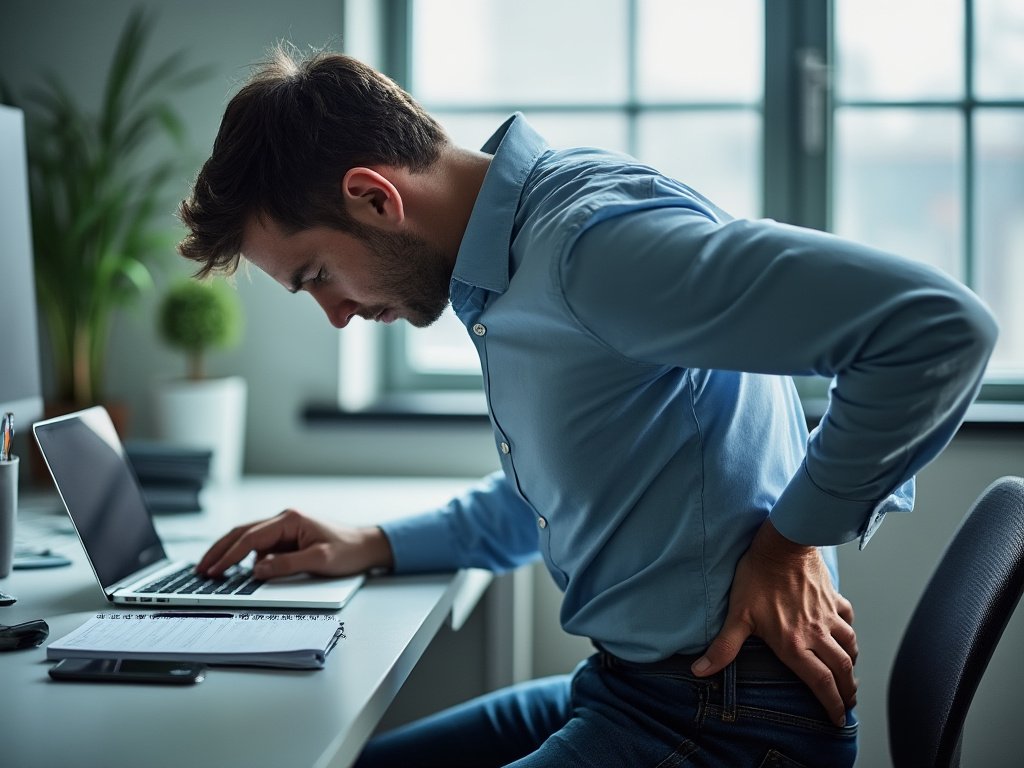Sitting Causing Pain?
Ever wonder why your back aches when you sit, stand or hold a position for a long period of time?
One of the reasons has to do with the sensors in your back. There is constant communication between the sensors in our muscles, joints, and ligaments and our brain and spinal cord.
This communication allows the body to accurately move all of our muscles in a coordinated and non-painful way.
When we hold a position for a long period of time these sensors becomes fatigued and they become less accurate. At this same time these sensors are competing with pain signals to the brain and spinal cord because they travel on the same pathway - think of it as a one land road.
When we are moving these sensors have the right of way on the one lane road and we feel less pain and maintain the sense of our position (joint position sense).
However, when we sit, stand, or awkwardly hold a position for a long period of time our muscles become fatigued and it alters the accuracy of the sensors. The sensors aren't able to give the brain or spinal cord accurate information - at the same time these sensors lose the right of way with the pain signals (nociceptors) and our chance of feeling pain increases.
What To Do?
Move and switch positions.
There are arguments about how sitting is the new smoking, it's not, or how you should stand all day - you don't need to.
What is most important is movement - switching positions and moving.
You burn nearly the same amount of calories if you are sitting compared to standing - you are holding a static position if you stand all day or sit all day. Holding any one position for a long period of time is going to lead to fatigue and for many eventually discomfort or pain.
So if you're someone that gets discomfort or pain when standing or sitting at work, remember to switch positions, to get up and move. Set a timer on your phone for what works for you, 20 - 30 - 40 - 60 minutes, and when it goes off - move.
Do some light stretches, go for a walk, or simply switch your position from sitting to standing or standing to sitting.
References
Jung, K. S., Jung, J. H., In, T. S., & Cho, H. Y. (2020). Effects of Prolonged Sitting with Slumped Posture on Trunk Muscular Fatigue in Adolescents with and without Chronic Lower Back Pain. Medicina (Kaunas, Lithuania), 57(1), 3. https://doi.org/10.3390/medicina57010003
Kett, Alexander R., Freddy Sichting, and Thomas L. Milani. 2021. "The Effect of Sitting Posture and Postural Activity on Low Back Muscle Stiffness" Biomechanics 1, no. 2: 214-224. https://doi.org/10.3390/biomechanics1020018
Korakakis, V., Giakas, G., Sideris, V., & Whiteley, R. (2017). Repeated end range spinal movement while seated abolishes the proprioceptive deficit induced by prolonged flexed sitting posture. A study assessing the statistical and clinical significance of spinal position sense. Musculoskeletal science & practice, 31, 9–20.
Saiklang, P. ., Chatprem, T., Karoonsupcharoen, O., Saiklang, P., & Puntumetakul, R. (2024). The Comparison of the Effect of Prolonged Sitting on Lumbar Repositioning Error in Asymptomatic and Chronic Low Back Pain Participants with Seated Sedentary Behavior. Trends in Sciences, 21(3), 7332. https://doi.org/10.48048/tis.2024.7332
Taylor, J. L., Amann, M., Duchateau, J., Meeusen, R., & Rice, C. L. (2016). Neural Contributions to Muscle Fatigue: From the Brain to the Muscle and Back Again. Medicine and science in sports and exercise, 48(11), 2294–2306. https://doi.org/10.1249/MSS.0000000000000923
